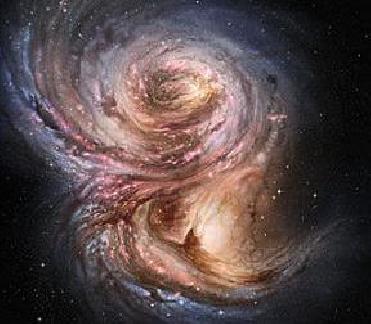
This artist�s impression of distant galaxy SMM J2135-0102 shows large bright clouds a few hundred light-years in size, which are regions of active star formation. An ESO Photo
PARIS (BNS): A distant galaxy which is a hot-bed of vigorous star formation has been spotted by astronomers who have, for the first time, made a direct measurement of the size and brightness of the star birth region.
The galaxy, named SMM J2135-0102, is so far away and its light has taken so long to reach us that we see it as it was 10 billion years ago.
European Southern Observatory's Atacama Pathfinder Experiment (APEX) telescope has zoomed in on the galaxy, using submillimetre wavelengths of light.
The glow emanating from the galaxy is very bright because the cosmic dust grains in it are glowing after being heated by starlight. Besides, the massive galaxy cluster that lies in the foreground, also adds to its brightness. The vast mass of this cluster bends the light of SMM J2135-0102, thereby acting as a gravitational lens.
�We were stunned to find a surprisingly bright object that wasn�t at the expected position. We soon realised it was a previously unknown and more distant galaxy being magnified by the closer galaxy cluster,� said Carlos De Breuck from ESO, a member of the team that made the discovery.
The observation made by the APEX telescope reveals a hectic and vigorous star-forming life for galaxies in the early Universe, with stellar nurseries forming one hundred times faster than in more recent galaxies.
These �star factories� are similar in size to those in the Milky Way, but one hundred times more luminous, suggesting that star formation in the early life of these galaxies is a much more vigorous process than typically found in galaxies that lie nearer to us in time and space.
According to the astronomers' estimation, the distant galaxy is producing stars at a very rapid rate. �We estimate that SMM J2135-0102 is producing stars at a rate that is equivalent to about 250 Suns per year,� said de Breuck.
The research is published in the journal Nature.
 Previous Article
Previous Article Next Article
Next Article













The Indian Air Force, in its flight trials evaluation report submitted before the Defence Ministry l..
view articleAn insight into the Medium Multi-Role Combat Aircraft competition...
view articleSky enthusiasts can now spot the International Space Station (ISS) commanded by Indian-American astr..
view article